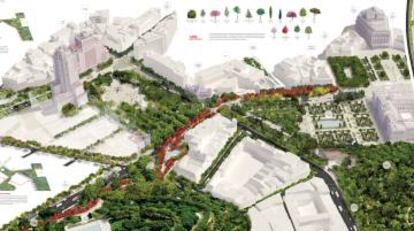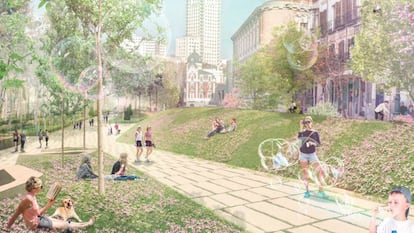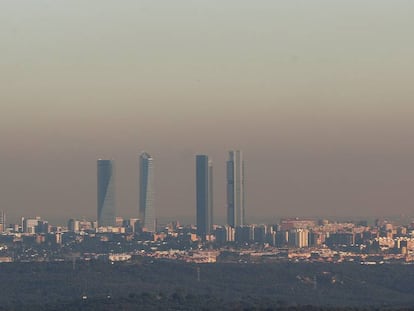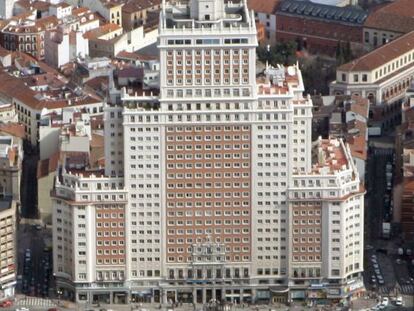Madrileños vote on new Plaza de España, but not all happy with process
Ballot to choose redesign for central park area derided as an expensive farce by opposition
Madrid’s Plaza de España, a largely overlooked patch of park at the northwestern end of Gran Vía, one of the city’s main thoroughfares, is set for a leafy makeover. After City Hall put forward a shortlist of design proposals to a referendum, a project entitled Welcome Mother Nature Good Bye Mr. Ford has emerged the winner, with 52.19% of the vote.
The new-look Plaza de España will connect with Gran Vía via an esplanade, while receiving around 1,000 new trees, among them olives and magnolias. At its center will be a large open area, while the monument to Miguel Cervantes, with Don Quixote and Sancho Panza at his feet, will be turned around to face the vast monolith of the Edificio España building, at the bottom of Gran Vía, and will be lined with a wall of water. The streets leading on to the square will also be given new trees.
The fact that just 8% of those eligible to vote did so has also attracted criticism
At the same time, says City Hall, the plan is to reduce the number of traffic lanes on Gran Vía, creating a more uniform thoroughfare where it converges with the entrance to Plaza de España.
Space for cyclists and pedestrians will be increased by extending a nearby road tunnel that passes under the Royal Palace, creating in the process a large green area that will connect Plaza de España with the Sabatini Gardens and the Egyptian Temple of Debod, which currently sit on the other side of a busy road to the southwest.
“The city is going to be greener, more accessible, and sustainable,” said a City Hall spokesman, adding that work will begin toward the end of the year. “Traffic will be reduced and the pedestrian zone will be enlarged,”

The popular vote to choose the winning design to remodel Plaza de España was part of a wider process initiated by Madrid Mayor Manuela Carmena, of left-leaning bloc Ahora Madrid, to involve the electorate in its plans to reduce traffic flows in the center of the city, which include the partial pedestrianization of Gran Vía by widening its pavements, giving priority to public transport and also improving squares off it. Some 66.7% of Madrid residents voted in favor of more space for pedestrians and up to 92% to give priority to public transport.
The exercise in direct democracy cost €1.1 million and attracted 212,000 Madrid residents aged over 16. But the fact that just 8% of those eligible to vote did so has also attracted criticism.
The spokesperson for the conservative Popular Party (PP) in City Hall, Esperanza Aguirre, was critical of the initiative from Ahora Madrid. “The only possible democracy is representative democracy,” she said in response to the vote, describing it as an exercise in “demagoguery.” “This farce has come at great cost,” she added, accusing Mayor Manuela Carmena of having political responsibility for the process. “Why didn’t they ask Madrileños if they wanted [the streets] cleaned more?”
This exercise in demagoguery was a farce, and has come at great cost Popular Party spokeswoman Esperanza Aguiree
But Pablo Soto, the city councilor who oversaw the organization of the poll, defended the initiative, saying the low turnout reflected a long-standing lack of confidence by voters in City Hall. “That will increase when people trust their institutions,” he says, adding: “It’s normal that half of people didn’t vote.”
The language used to describe City Hall’s plans to alter the area around Gran Vía has also come under scrutiny: “improve,” which critics say suggests that anybody not in agreement with the proposals opposes improving the area: there was no alternative to City Hall’s plans. Furthermore, among the four questions, the “Yes” option ratified City Hall’s project, while no figures were provided on how much the remodeling of the area would cost.
But Rita Maestre, spokeswoman for Ahora Madrid, which took over City Hall in 2015, described the referendum as “highly successful,” noting: “We have to find more ways and more possibilities for participation.”
English version by Nick Lyne.
Tu suscripción se está usando en otro dispositivo
¿Quieres añadir otro usuario a tu suscripción?
Si continúas leyendo en este dispositivo, no se podrá leer en el otro.
FlechaTu suscripción se está usando en otro dispositivo y solo puedes acceder a EL PAÍS desde un dispositivo a la vez.
Si quieres compartir tu cuenta, cambia tu suscripción a la modalidad Premium, así podrás añadir otro usuario. Cada uno accederá con su propia cuenta de email, lo que os permitirá personalizar vuestra experiencia en EL PAÍS.
¿Tienes una suscripción de empresa? Accede aquí para contratar más cuentas.
En el caso de no saber quién está usando tu cuenta, te recomendamos cambiar tu contraseña aquí.
Si decides continuar compartiendo tu cuenta, este mensaje se mostrará en tu dispositivo y en el de la otra persona que está usando tu cuenta de forma indefinida, afectando a tu experiencia de lectura. Puedes consultar aquí los términos y condiciones de la suscripción digital.
More information
Últimas noticias
The complicated life of Francesca Albanese: A rising figure in Italy but barred from every bank by Trump’s sanctions
How Japan is trying to avert ‘digital defeat’
Half of Scotland is in the hands of 420 property owners
From digital curfews to blocking apps: How technology experts protect their children online
Most viewed
- Why we lost the habit of sleeping in two segments and how that changed our sense of time
- Pablo Escobar’s hippos: A serious environmental problem, 40 years on
- Trump’s obsession with putting his name on everything is unprecedented in the United States
- The Florida Keys tourist paradise is besieged by immigration agents: ‘We’ve never seen anything like this’
- Charles Dubouloz, mountaineering star, retires at 36 with a farewell tour inspired by Walter Bonatti











































